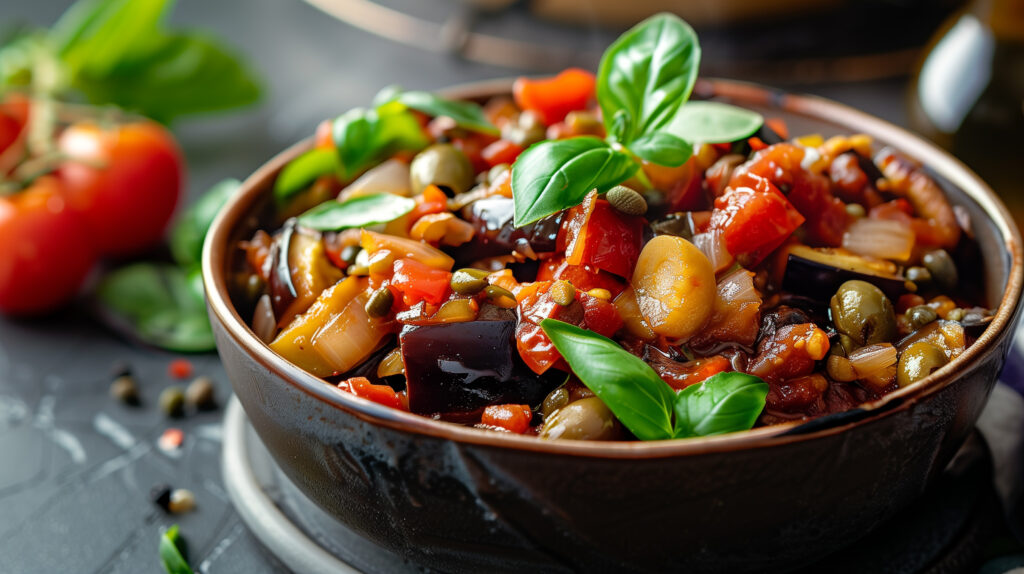
Sicilian Eggplant Caponata: A Sweet and Tangy Italian Delight
Sicilian Eggplant Caponata is a traditional Italian dish that blends sweet, tangy, and savory flavors into a harmonious medley of vegetables. Centered around tender eggplant, caponata is enhanced with tomatoes, olives, capers, and a touch of vinegar. Chef Abdul, known for his passion for authentic Italian cuisine, shares his recipe and tips for crafting the perfect Sicilian Caponata. Whether served as an appetizer, side dish, or light meal, this vibrant dish captures the essence of Sicily.
The History of Caponata
Caponata has been a staple of Sicilian cuisine for centuries, with origins rooted in Mediterranean trade and the island’s diverse culinary influences. Traditionally served as a relish or accompaniment to bread, caponata reflects Sicily’s agricultural bounty and love for bold, balanced flavors.
“Caponata is a dish that tells the story of Sicily’s history, blending influences from Arab, Spanish, and Italian cuisines,” says Chef Abdul.
Ingredients
- 2 medium eggplants, diced into 1/2-inch cubes
- 1/4 cup olive oil (plus extra for sautéing)
- 1 medium onion, finely chopped
- 2 garlic cloves, minced
- 2 celery stalks, diced
- 1 cup canned diced tomatoes (or fresh tomatoes, peeled and chopped)
- 1/4 cup green olives, pitted and sliced
- 2 tablespoons capers, rinsed
- 2 tablespoons red wine vinegar
- 1 tablespoon sugar
- Salt and black pepper to taste
- 1/4 cup fresh parsley, chopped (for garnish)
- Optional: Toasted pine nuts for topping
Method to Make Sicilian Eggplant Caponata
- Prepare the Eggplant:
- Sprinkle the diced eggplant with salt and let it sit for 20-30 minutes to draw out excess moisture and bitterness. Rinse and pat dry.
- Fry the Eggplant:
- Heat olive oil in a large skillet over medium heat. Fry the eggplant in batches until golden and tender. Remove and drain on paper towels.
- Cook the Vegetables:
- In the same skillet, add a bit more olive oil if needed. Sauté the onion, garlic, and celery until softened and fragrant.
- Add Tomatoes and Seasoning:
- Stir in the diced tomatoes, olives, capers, red wine vinegar, and sugar. Simmer for 10 minutes, allowing the flavors to meld.
- Combine the Eggplant:
- Return the fried eggplant to the skillet and stir to combine. Cook for an additional 5 minutes, seasoning with salt and black pepper to taste.
- Cool and Serve:
- Remove from heat and let the caponata cool to room temperature. Garnish with fresh parsley and toasted pine nuts if desired. Serve with crusty bread or as a side dish.
Tips for Success
- Eggplant Preparation: Salting the eggplant is crucial to remove bitterness and achieve a creamy texture.
- Balance the Flavors: Adjust the vinegar and sugar to strike the perfect balance between sweet and tangy.
- Make Ahead: Caponata tastes even better the next day as the flavors deepen over time.
Variations of Sicilian Caponata
- Zucchini Caponata: Replace or mix eggplant with diced zucchini for a lighter variation.
- Spicy Caponata: Add red chili flakes for a hint of heat.
- Seafood Twist: Stir in cooked shrimp or anchovies for a protein-packed version.
- Herbaceous Caponata: Add fresh basil or oregano for extra aroma.
- Vegan Caponata: Caponata is naturally vegan, making it a perfect choice for plant-based diets.
Pairings for Sicilian Eggplant Caponata
- Bread: Serve with toasted ciabatta or focaccia for a classic pairing.
- Cheese: Pair with fresh ricotta or burrata for a creamy contrast.
Wine: A glass of dry white wine, such as Vermentino or Grillo, complements the dish beautifully
Conclusion
Sicilian Eggplant Caponata is a versatile and flavorful dish that showcases the rich culinary heritage of Sicily. Chef Abdul’s recipe ensures a perfect balance of textures and flavors, making it a must-try for anyone looking to explore Mediterranean cuisine. Whether enjoyed as a starter, side, or main dish, caponata brings a taste of Sicily to your table.
As Chef Abdul puts it, “Caponata is a dish that embodies the heart of Sicilian cooking: vibrant, bold, and deeply satisfying.”

